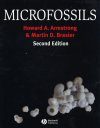![Microfossils Microfossils]()
Click to have a closer look
About this book
Contents
Customer reviews
Biography
Related titles
About this book
Covers all the main microfossil groups, from Precambrian procaryotes, through the wide range of protistan fossils, to plant and animal remains, arranged taxonomically.
Contents
Preface Part 1 Applied micropalaeontology: Chapter 1 Introduction Chapter 2 Micropalaeontology, evolution and biodiversity Chapter 3 Microfossils in Stratigraphy Chapter 4 Microfossils, stable isotopes and ocean-atmosphere history Chapter 5 Microfossils as thermal metamorphic indicators Part 2 The rise of the biosphere: Chapter 6 The origin of life and the Archean biosphere Chapter 7 Emergence of eukaryotes to the Cambrian explosion Chapter 8 Bacterial ecosystems and microbial sediments Part 3 Organic walled microfossils: Chapter 9 Acritarchs and prasinophytes Chapter 10 Dinoflagellates and Ebridians Chapter 11 Chitinozoa Chapter 12 Scolecodonts Chapter 13 Spores and pollen Part 4 Inorganic walled microfossils: Chapter 14 Calcareous nannoplankton: Coccolithophores and Discoasters Chapter 15 Formainifera Chapter 16 Radiozoa (Acantharia, Phaeodaria and Radiolaria) and Heliozoa Chapter 17 Diatoms Chapter 18 Silicoflagellates and Chrysophytes Chapter 19 Ciliophora: Tintinnids and Calpionellids Chapter 20 Ostracods Chapter 21 Conodonts Systematic Index General Index
Customer Reviews
Biography
Howard Armstrong has undertaken research in micropalaeontology for the past 20 years, mainly on Palaeozoic microfossil groups, and has published in a range of areas including applied micropalaeontology, numerical biostratigraphy, conodont palaeobiology and dispersal biogeography. His research currently focuses on elucidating patterns and processes associated with Palaeozoic glaciations. He is Senior Lecturer in Micropalaeontology at the University of Durham. Martin Brasier began research as a marine biologist aboard HMS Fox in 1970, mapping the microbial ecology of Caribbean reefs and algal mats. The author is well known for the first edition of Microfossils and for his work on early biosphere evolution, integrating microfossils, biogeochemistry and chemostratigraphy from the earliest signs of life in the Archaean through to the Cambrian explosion of multicellular forms. He maintains a special interest in the metabolism and evolution of bacterial and protist fossil groups, and has worked with NASA on the protocols for recognition of the earliest life on Earth and beyond. He is currently Professor of Palaeobiology at the University of Oxford.























![Pravěký Svět Zdeňka Buriana, Kniha 2: Monstra Třetihor a Čtvrtohor [The Prehistoric World of Zdeněk Burian, Volume 2: Tertiary and Quaternary Monsters]](http://mediacdn.nhbs.com/jackets/jackets_resizer_medium/26/263198.jpg?height=150&width=108)











